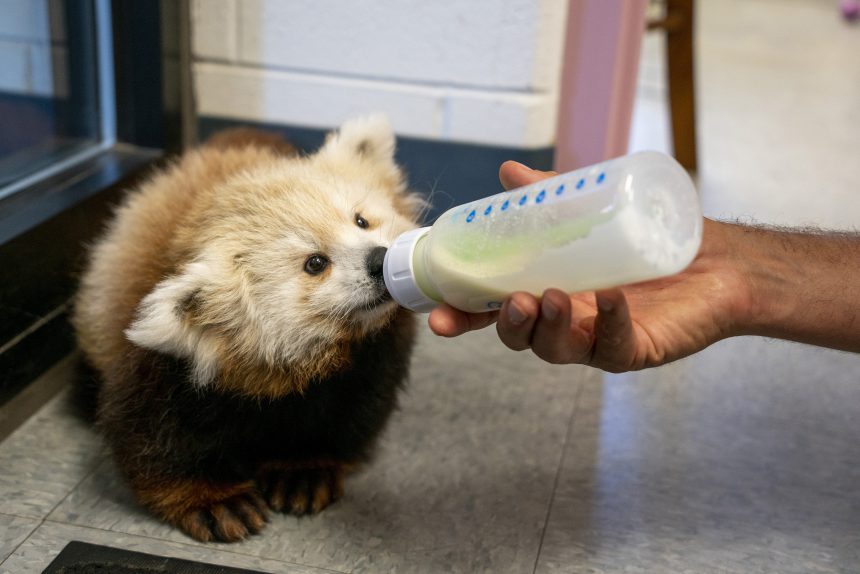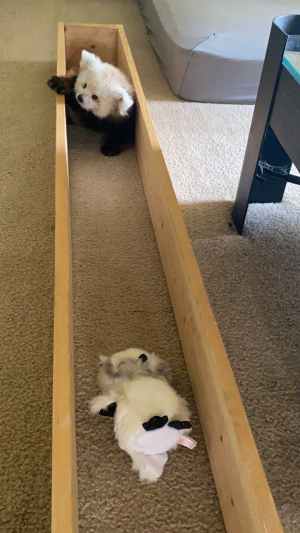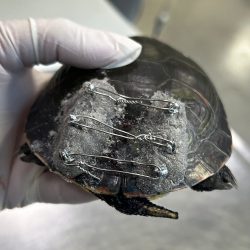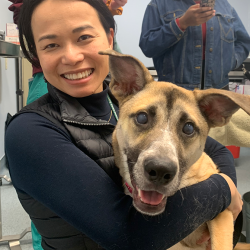Raya is a young red panda who lives at Potawatomi Zoo in South Bend, Indiana. At only a year and a half of age, Raya has overcome numerous health challenges thanks to the dedication of her caretakers and medical team—including some a state away!

Featuring Dr. Audrey Siegrist, veterinarian at Potawatomi Zoo; Dr. Robert Sanders, associate professor of Small Animal Clinical Sciences at the MSU Veterinary Medical Center
Before ever journeying to the Michigan State University Veterinary Medical Center for care, however, Raya conquered a few obstacles while at home.
As A Newborn
“Raya’s case has been long and complicated already for a one-year-old panda!” says Dr. Audrey Siegrist, the veterinarian at Potawatomi Zoo. “She had to be pulled from her mom and sibling as a newborn and hand-raised due to aspiration pneumonia.”
Aspiration pneumonia is an infection of the lungs caused by breathing food and liquid into the airway, and left her too weak to nurse naturally. The infection required the newborn cub to be fed via syringe and kept in an incubator. Zoo staff kept her on 24-hour care.
“Red pandas are known to be challenging to hand-rear, but Raya made it through,” says Siegrist.
Though the pneumonia cleared up, as Raya grew, her hind legs struggled. She developed splay leg, also known as swimmer syndrome, a deformity that impacts an animal’s ability to stand or walk. Often associated with dogs, the condition is characterized by legs that splay out to the animal’s sides while they lay on their abdomen.
To help Raya improve her hind leg muscles, the Potawatomi Zoo team enacted a little DIY magic, placing her in a custom-made exercise track for daily physical therapy. She also wore hobbles, a type of brace that prevented her legs from splaying.
In time, Raya’s gait improved significantly.
“She was able to be reunited with her mom and sibling after several months, but still maintains a bond with her humans,” says Siegrist.

Investigating the Heart
While treating Raya for suspected toxoplasmosis (a parasitic infection commonly associated with cats), the Zoo medical team discovered no parasites, but a heart murmur and a suspected enlarged right atrium. They performed an electrocardiogram and conducted bloodwork, but the results seemed normal. Additional, in-depth diagnostics were needed to identify any congenital cardiac disease or malformation.
“That is where MSU comes in,” says Dr. Siegrist.
Raya was brought northeast for a full cardiac workup at the MSU Veterinary Medical Center. Dr. Robert Sanders of the Hospital’s Cardiology Service performed an echocardiogram, which showed valve regurgitation. This means Raya’s heart valves were leaky. This is often a minor condition, but it can place strain on the heart by requiring it to work harder or pump less blood.

Apart from revealing valve regurgitation, the echocardiogram found no major defects or size abnormalities in the atrium—fortunately, Raya’s heart was big only in a metaphorical sense! The test also confirmed that there was no evidence of heartworm disease in Raya.
Moving forward
To keep Raya and her heart in the best shape they could, her team of Zoo and MSU experts prescribed her a anti-parasite medication (as her enclosure mate had gone through a toxoplasmosis infection recently) to take daily for one month. Raya’s weight was rechecked weekly, and she would later return to MSU for another cardiac exam.
Six months later, Raya and her team made the two-and-a-half-hour journey to East Lansing. There, testing revealed that her heart was stable. She no longer needed any medication, and could go home to Potawatomi Zoo with her caretakers at ease. It was recommended that Raya be examined again in another nine months.
“She has been playful and active,” says Siegrist, “with no signs of problems. We are so grateful to MSU for all of the great care that Raya has received!”



